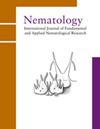Reaction of soybean cultivars to two races of Meloidogyne enterolobii and their aggressiveness under plastic house conditions
IF 1.1
4区 生物学
Q2 ZOOLOGY
引用次数: 0
Abstract
Limited information is available regarding the susceptibility or resistance of soybean cultivars to Meloidogyne enterolobii. Recently, a new race of this species was detected in Brazil parasitising cotton and soybean. This nematode has the potential to pose a problem in both of these crops, since it is pathogenic and virulent to several economically important plants that have resistance genes to other Meloidogyne species. The aim of this study was to assess the responses of EMBRAPA’s main soybean cultivars with confirmed resistance to M. incognita and M. javanica to the two races of M. enterolobii detected in Brazil. Additionally, this study aimed to characterise the aggressiveness of these nematode races. The experiments were conducted in a plastic house, in a factorial scheme with 16 soybean cultivars × two M. enterolobii races (guava and cotton), totalling 32 treatments × eight replications, and evaluated with two replications over time. Soybean sowing took place in pots containing 1.7 l of a mixture of soil, sand and Bioplant® substrate (1:1:1), previously autoclaved. Each soybean plant was inoculated with 5000 eggs of M. enterolobii. After 75 days for the first experiment, and 90 days for the second, the following variables were evaluated: gall index (GI), egg mass index (EMI), total number of eggs per g root (NEGR) and the reproduction factor (RF). Both races of M. enterolobii showed reproductive ability in all soybean genotypes (with or without known genetic resistance), albeit with moderate to low values in comparison to their reproduction on tomato plants. The race from cotton was considered statistically more aggressive than the guava population on soybean cultivars. Only ‘BRS 7180 IPRO’ was moderately resistant to both races in both experiments. In view of the importance and prospects for expansion of the soybean crop, the findings of this study contribute to a better understanding of the resistance and aggressiveness exhibited by the two races of M. enterolobii, Moreover, the study highlights the significant challenge that lies ahead in developing breeding programmes to select soybean genotypes with multiple resistance to Meloidogyne spp.大豆品种对2个小种肠曲裂蝇的反应及其在塑料温室条件下的侵袭性
关于大豆品种对肠根结线虫的易感性或抗性的信息有限。最近,在巴西发现了一个寄生在棉花和大豆上的新品种。这种线虫有可能在这两种作物中造成问题,因为它对几种对其他根结线虫物种具有抗性基因的经济重要植物具有致病性和毒力。本研究的目的是评估EMBRAPA的主要大豆品种对在巴西检测到的两个小种的M.enterolobii的反应。此外,本研究旨在描述这些线虫小种的攻击性。实验在塑料房中进行,采用析因方案,用16个大豆品种×两个肠叶豆小种(番石榴和棉花),共32个处理×8个重复,并随着时间的推移用两个重复进行评估。大豆播种在盛有1.7升土壤、沙子和Bioplant®基质(1:1:1)混合物的花盆中进行,之前经过高压灭菌。每株大豆植株接种5000个肠杆菌卵。第一个实验75天后,第二个实验90天后,评估以下变量:胆囊指数(GI)、卵子质量指数(EMI)、每克根卵子总数(NEGR)和繁殖因子(RF)。两个小种在所有大豆基因型中都表现出繁殖能力(具有或不具有已知的遗传抗性),尽管与它们在番茄植株上的繁殖相比具有中等到较低的值。从统计数据来看,棉花品种比番石榴品种对大豆品种更具攻击性。在两个实验中,只有“BRS 7180 IPRO”对两个小种都具有中等抗性。鉴于扩大大豆作物的重要性和前景,本研究的结果有助于更好地了解两个小种M.enterolobii表现出的抗性和攻击性。此外,这项研究强调了在制定育种计划以选择对根结线虫具有多重抗性的大豆基因型方面面临的重大挑战。
本文章由计算机程序翻译,如有差异,请以英文原文为准。
求助全文
约1分钟内获得全文
求助全文
来源期刊

Nematology
生物-动物学
CiteScore
2.60
自引率
33.30%
发文量
67
审稿时长
3 months
期刊介绍:
Nematology is an international journal for the publication of all aspects of nematological research (with the exception of vertebrate parasitology), from molecular biology to field studies. Papers on nematode parasites of arthropods, and on soil free-living nematodes, and on interactions of these and other organisms, are particularly welcome. Research on fresh water and marine nematodes is also considered when the observations are of more general interest.
Nematology publishes full research papers, short communications, Forum articles (which permit an author to express a view on current or fundamental subjects), perspectives on nematology, and reviews of books and other media.
 求助内容:
求助内容: 应助结果提醒方式:
应助结果提醒方式:


